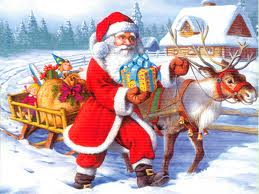[source: About.com/German Language]
1. Wer ist Sankt Nikolaus?
Who is Saint Nicholas indeed?
Every Christmas I get email asking about “Belsnickle,” “Pelznickel,” “Tannenbaum,” or some other German-American Christmas custom. The other day, as I prepared to write yet another reply, it dawned on me that it was time to do an article on this topic. Since the Germans (and the Dutch) brought many of their customs to America directly or indirectly, we need to look at Europe first.
Across the German-speaking region of Europe there are many kinds of Santa Clauses with many different names. Despite their many names, they are all basically the same mythic character. But few of them have anything to do with the real Saint Nicholas (Sankt Nikolaus or der heilige Nikolaus), who was probably born around A.D. 245 in the port city of Patara in what we now call Turkey. Very little solid historical evidence exists for the man who later became the Bishop of Myra and the patron saint of children, sailors, students, teachers, and merchants. He is credited with several miracles and his feast day is Dec. 6, which is the main reason he is connected with Christmas. In Austria, parts of Germany, and Switzerland, der heilige Nikolaus (or Pelznickel) brings his gifts for children on Nikolaustag, Dec. 6, not Dec. 25. Nowadays, St. Nicholas Day (der Nikolaustag) on Dec. 6 is a preliminary round for Christmas.
Although Austria is mostly Catholic, Germany is almost evenly divided between Protestants and Catholics (along with some minority religions). So in Germany there are both Catholic (katholisch) and Protestant (evangelisch) Christmas customs. When Martin Luther, the great Protestant Reformer, came along, he wanted to get rid of the Catholic elements of Christmas. To replace Sankt Nikolaus (Protestants don't have saints!), Luther introduced das Christkindl (an angel-like Christ Child) to bring Christmas gifts and reduce the importance of Saint Nicholas. Later this Christkindl figure would evolve into der Weihnachtsmann (Father Christmas) in Protestant regions and even cross the Atlantic to mutate into the English term “Kris Kringle.”
“Ja, und ich bin der Weihnachtsmann!”
“Yes, and I'm Santa Claus!”
(Said when you doubt what someone has just said.)
Besides the Catholic and Protestant aspects, Germany is a country of many regions and regional dialects, making the question of who Santa Claus is even more complicated. There are in fact so many German names (and customs) for Nikolaus and his escorts that I have created a special Nikolaus Glossary just for all the names. On top of that, there are both religious and secular German Christmas customs. (That American Santa Claus has really gotten around!) However, on the next page we'll summarize some of the main German Christmas characters and customs.



































No comments:
Post a Comment